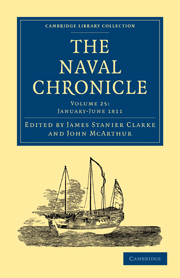 The Naval Chronicle
The Naval Chronicle Book contents
- Frontmatter
- PLATES IN VOLUME XXV
- PREFACE TO THE TWENTY-FIFTH VOLUME
- MEMOIR OF THE PUBLIC SERVICES OF THE LATE CAPTAIN HENRY INMAN, OF THE ROYAL NAVY
- MEMOIR OF THE PUBLIC SERVICES OF CAPTAIN NICHOLAS TOMLINSON, OF THE ROYAL NAVY
- MEMOIR OF THE PUBLIC SERVICES OF THE LATE HONOURABLE JOHN FORBES, ADMIRAL OF THE FLEET, &c.
- MEMOIR OF THE PUBLIC SERVICES OF THE LATE CAPTAIN ARTHUR FORREST, OF THE ROYAL NAVY
- ADDENDA TO THE BIOGRAPHICAL MEMOIR OF SIR ERASMUS GOWER, KNT. ADMIRAL OF THE WHITE SQUADRON
- INDEX
ADDENDA TO THE BIOGRAPHICAL MEMOIR OF SIR ERASMUS GOWER, KNT. ADMIRAL OF THE WHITE SQUADRON
Published online by Cambridge University Press: 10 January 2011
- Frontmatter
- PLATES IN VOLUME XXV
- PREFACE TO THE TWENTY-FIFTH VOLUME
- MEMOIR OF THE PUBLIC SERVICES OF THE LATE CAPTAIN HENRY INMAN, OF THE ROYAL NAVY
- MEMOIR OF THE PUBLIC SERVICES OF CAPTAIN NICHOLAS TOMLINSON, OF THE ROYAL NAVY
- MEMOIR OF THE PUBLIC SERVICES OF THE LATE HONOURABLE JOHN FORBES, ADMIRAL OF THE FLEET, &c.
- MEMOIR OF THE PUBLIC SERVICES OF THE LATE CAPTAIN ARTHUR FORREST, OF THE ROYAL NAVY
- ADDENDA TO THE BIOGRAPHICAL MEMOIR OF SIR ERASMUS GOWER, KNT. ADMIRAL OF THE WHITE SQUADRON
- INDEX
Summary
The period at which Sir Erasmus Gower's biographer concluded the detail of that officer's services, was not the termination of his professional career. On the 9th of February, 1801, he hoisted his flag, as rear-admiral of the white squadron, in the Princess Royal, of 98 guns, and joined the Channel fle t, then under the command of Admiral Cornwallis. During this year, the preliminaries of peace with France were signed; and, on the 13th of the ensuing February (1802) when, in expectancy of the memorable treaty of Amiens, preparations were making for the reduction of our naval establishment, Sir Erasmus struck his flag.
From that time, he remained unemployed until the 21st of May, 1804; when, as vice-admiral of the white, to which rank he had been promoted on the 23d of the preceding April, he was appointed commander-in-chief and governor of Newfoundland. This highly responsible command he held until the 12th of March, 1807, being the full term of three years, for which it is usually delegated. During this service he obtained the rank of vice-admiral of the red; an event which took place on the 9th of April, 1805. The Isis, of 50 guns, bore his flag the whole period of his command.
The government of Newfoundland was peculiarly adapted to the disposition and character of Sir Erasmus Gower, as affording a full opportunity for the display of that beneficence and philanthropy which he so eminently possesses.
- Type
- Chapter
- Information
- The Naval ChronicleContaining a General and Biographical History of the Royal Navy of the United Kingdom with a Variety of Original Papers on Nautical Subjects, pp. 452 - 515Publisher: Cambridge University PressPrint publication year: 2010First published in: 1811


